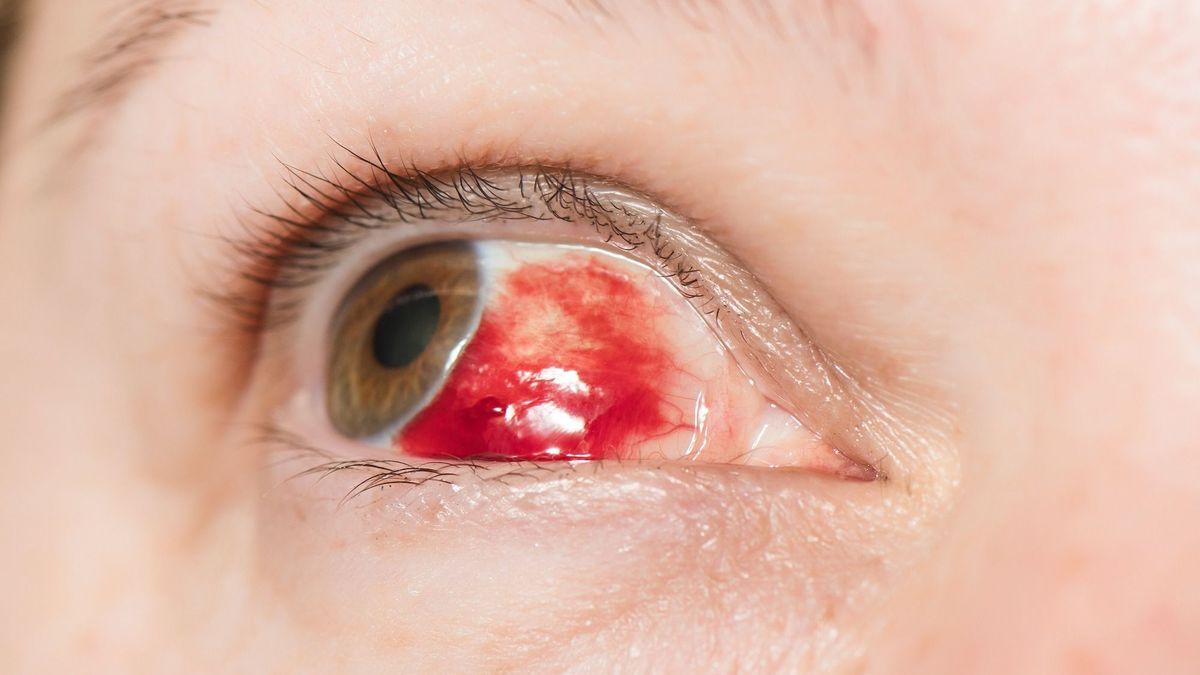
Published on
Updated
What is a subconjunctival hemorrhage? In what cases does it occur, is it serious and how to treat it? The lighting of ophthalmologist Barbara Ameline-Chalumeau.
Do you have a small red spot in your eye that is painless and does not impact your vision? Maybe it’s a subconjunctival hemorrhage. “It is most often a benign eye condition”reassures Doctor Barbara Ameline-Chalumeau, ophthalmologist surgeon and Vice-President of the French Society of Ophthalmology (SFO).
Subconjunctival hemorrhage: definition
“Subconjunctival hemorrhage is manifested by the appearance of a small pocket of blood which most often affects only one eye and can occur at any time”, reports Doctor Barbara Ameline-Chalumeau. Sometimes, for no particular reason, you wake up with a subconjunctival hemorrhage. Although it is more common in adults, this small eye condition can also occur in children. “It is never serious, because it is not accompanied by a loss of vision”adds the ophthalmologist.
Symptoms of a subconjunctival hemorrhage
As for symptoms, this eye condition is therefore unilateral and does not impact vision. “Subconjunctival hemorrhages do not, therefore, no character of gravity”, insists the Vice-President of the French Society of Ophthalmology. She is painlessdoes not particularly make you watery, but can occasionally cause a little discomfort because it makes the conjunctiva swell, so you may have the sensation of a little discomfort under the eyelid.
In short, it is a small bleeding giving way to a red spot, more or less large: “it can sometimes completely cover the white of the eye, what we call the conjunctiva, and can then be visually impressive. Sometimes, on the contrary, it is hidden under the eyelid and therefore invisible, which means that the person is unaware of its presence”, notes dr. Ameline-Chalumeau.
Subconjunctival hemorrhage: what are the causes?
“A subconjunctival hemorrhage can cause following traumabut, more often, it occurs spontaneouslyfor no particular reason”, observes the ophthalmologist. The only risk factors according to her: high blood pressure which can promote its appearance, as well as taking anticoagulant treatment. Moreover, if you are taking anti-coagulants – which puts you more at risk of subconjunctival hemorrhage – you should definitely not stop your treatment, even if you have a subconjunctival hemorrhage.
Indeed, in general, the reason for taking anti-coagulants is more serious (for example, cardiovascular problems) than the consequences themselves, that is to say the seriousness of the subconjunctival hemorrhage. On the other hand, the specialist then advises going for a consultation. “Even if, a priori, it is not serious, it is better to check that the dosage of anticoagulants is correct”she says.
When to consult?
In short, for Dr. Barbara Ameline-Chalumeau, in the event of “a single subconjunctival hemorrhage, occurring isolated in life, without associated disorder or pathology, there is no cause for concern”. If it happens again, you should talk to your doctor., that he check blood pressure and any necessary tests. Same if taking anticoagulantsto check the dosage.
Diagnostic
As explained by dr. Ameline-Chalumeau, self-diagnosis of this condition is relatively simple: it is a dense and clear bloodstain, painless and does not impact the person’s eyesight. Different therefore when examining a conjunctivitis which will be spread a little on the eye and cause a feeling of discomfort and possibly a stuck eye in the morning.
It is also distinguished from trachomea chronic disease more present in tropical countries, which does not give rise to hemorrhage. “Trachoma results in repeated conjunctivitis which will damage the surface of the eye and gradually degrade vision through loss of transparency of the cornea”analyzes the specialist.
This condition should not be confused either with scleritisan inflammation of the deep layer of the eye (the sclera) which constitutes the wall of the globe. “Scleritis will give rise to a small localized redness, possibly with a small white dot in the center, but will never have the density of the hemorrhage”, notes Barbara Ameline-Chalumeau. In the event of scleritis, she advises consulting an ophthalmologist so that he can carry out an examination and carry out an ophthalmic assessment.
Treatments
As the Vice-President of the French Society of Ophthalmology explains, a subconjunctival hemorrhage will last between 10 and 15 days and does not require any special treatment. It will go away on its own and administering eye drops to the eyes will have no effect.
